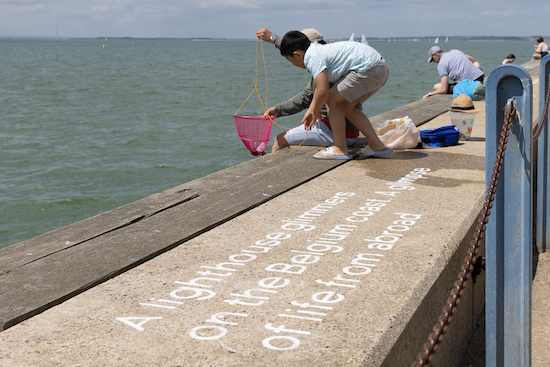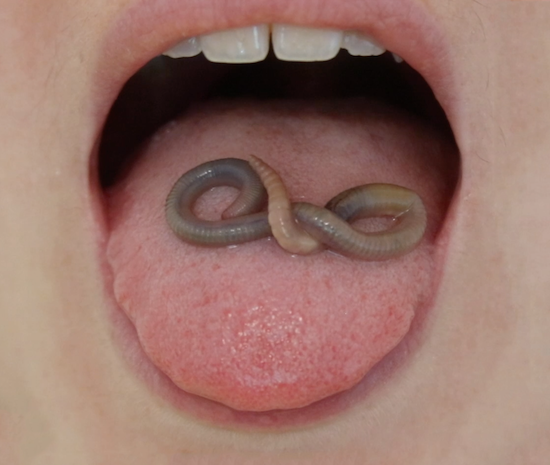Alicia Radage, Underneath Infinity
“What about the sea?”
“Is it relevant? It’s not as if we go there. I’ve heard it’s slowed down.”
It’s not just the sea dying in Jennet Thomas’ film The Great Curdling, animals too seem to be flirting with anthropogenic extinction. Across an unnerving domestic drama set in a near-future, we discover in the “folk sci-fi musical” that mourning the loss of nature is not encouraged by the state, though consumption of “The Substance” is. It seems to pacify the population, and is perhaps why the characters seem less disturbed than we viewers are at half-cartoon creatures emerging from the sea, a cult forming around them instead of considering them as harbingers of destroyed ecosystem.
Perhaps unsurprisingly for a Biennale located in a town so connected culturally and physically to the estuary lapping against it, water is a recurring theme across the works. Not only appearing in the Thomas film, but also in Ephemeral Evidence, by Chromatic Agency (nnull and Sandy Rompotiyoke), a work using film, activism, and law to explore decisions by Southern Water to dispose sewage into local waters, and the corporate decision to take a £90m governmental fine rather than responsibility.
Eco-Hauntology, an installation by Sarah Craske, one of three artists supported also by Jerwood Arts, reminisces about the 1953 floods, simulating a water vapour feedback loop with scientific equipment, in effect creating a microcosm of the closed-loop system of our planetary system. But as with other watery-works, there is an inherent warning, speaking to the complex relationships and systems we are damaging at a faster rate than ever before.
In Alicia Radage’s MOTHER BENT the artist stands like Canute in a bay where Brazilian sands meet the Atlantic, one a number of video tableaux surreally woven into a mixed-media installation comprising prosthetics of artist’s body – fingers, ears, tongues – skewered onto nature-like metal growths emerging from a soil bed across 1960s former town library. At-first it’s disturbing. Then slowly it speaks to a more connected relationship to nature, and also of the artist’s Shamanic practice working with “non-human allies.”
An emergent radical utopia is also present in Webb-Ellis’ film This place is a message, projected in a Methodist Church surrounded by large-scale portraits made with over-sized quarry chalk. The artists spent five days in a Kent quarry with a small group of Gravesend students, exploring non-verbal communication, the meaning of language, and creating new modes of expression. Part narrative, part documentary, it has something Ballardian or Lord of the Flies about it, adolescents trying to find themselves within a world which has crashed and burnt, but with a humour and hope.
Biennale director Sue Jones is proud that art is not just dropped-into the town,. Instead, artists spend time developing ideas and work for a specific location, and can do so with no overarching curatorial motif. Water may saturate much of the work in this edition, but it’s somewhat coincidental, as Jones prefers “to leave the works are they are in their own space, rather than imposing a theme,” resulting in a visitor experience of genuine unexpected encounter and experience.

Leo Boix, Haikus for the Pandemic, Whitstable Biennale 2022. Photo: Rob Harris
This can be seen most interestingly with how poetry floods Whitstable this year. The Biennale’s first Poet in Residence, Dzifa Benson, has worked with the curators to inject language across the fabric of the place. She has brought together the work of poets from thirty countries, found written across the walls, pavements, flags, and sails of the town. There is a Roger Robinson poem printed onto fish and chip paper and another from Mona Arshi on ice-cream cone wrapping.
“We didn’t want a recital,” Benson said, commenting that poetry is too often compounded into a certain type of festival and not free to attach itself to wider art forms and modes of display. One poem, Mimi Khalvati’s Afterwardness, is written large across the Harbour itself, lending the word Afterward – invented by Sigmund Freud to articulate the “belated understanding of past events that coalesces with the passing of time” – to the title of the wider Biennale. “An eleven year-old boy from Aleppo whose eyes hold only things no longer there,” it begins, perhaps hauntingly recalling the tragedy of two-year-old Alan Kurdi, found dead on another waters edge in Turkey seven years ago.
The films of Thomas and Chromatic Agency, alongside Craske’s installation, have been relocated to The Old Bank from their original location, The Cockle Shed, a black-timber faced building on Whitstable’s harbourfront, also due to host four other works. The Biennale is designed to be town-immersive, taking over unexpected buildings and offering artists the opportunity to use non-gallery spaces, and the organisers were particularly excited to be including such a prominent building. However, just two weeks before the Biennale began, a fire broke out and the venue – including one of the artworks which had begun to be installed – was lost. Sad for the town, and a complex problem for a curator.
A sudden shift of works and creative adaption was required, though for a Biennial rooted in playful and irreverent curation, it seems that while not welcome, director Sue Jones and her team took the challenge in their stride. “We are anyway a festival dealing with adaption,” Jones states without showing an undoubted last-minute anxiety.
A visitor headed to Madeleine Ruggi’s TRANSMISSION—CARRIER, selected from an open call, would walk past the burnt remains of The Cockle Shed. The only work situated (technically) outside of Whitstable, Ruggi has created a sound installation lasting the duration of a boat trip exploring the turbines and sea forts of the mid-estuary. Her narration begins as a travelogue, discussing the town’s former coal trade and commodity in relation to water, but upon departure as the town gets smaller and waves get choppier, the commentary slips with glitches and interference.
The voiceover describes liquid thresholds crossed, from Port Authority into governmental waters, and as wind and waves increase, boundaries feel indeterminate. So too is the fidelity of the sound installation, until eventually one stops listening to the prose, allowing it simply to melt into the experience of airborne moisture, recalibrating the body to the boat’s movement, and the white noise of wind and water. Both work and place are porous.
The boat floats under eighty-metre-long turbine blades, relentlessly falling down, then drifts around the Maunsell Forts, once WW2 military infrastructure later repurposed as the base for pirate radio. Ruggi’s audio work has something of the longwave about it, always unreliable, but compelling.


